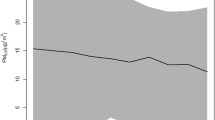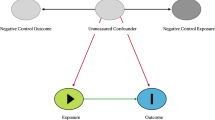Abstract
Epidemiological analyses of air quality often estimate human exposure from ambient monitoring data, potentially leading to exposure misclassification and subsequent bias in estimated health risks. To investigate this, we conducted a case-crossover study of summertime ambient ozone and fine particulate matter (PM2.5) levels and daily respiratory hospitalizations in New York City during 2001–2005. Comparisons were made between associations estimated using two pollutant exposure metrics: observed concentrations and predicted exposures from the EPA’s Stochastic Human Exposure and Dose Simulation (SHEDS) model. Small, positive associations between interquartile range mean ozone concentrations and hospitalizations were observed and were strongest for 0-day lags (hazard ratio (HR)=1.013, 95% confidence interval (CI): 0.998, 1.029) and 3-day lags (HR=1.006, 95% CI: 0.991, 1.021); applying mean predicted ozone exposures yielded similar results. PM2.5 was also associated with admissions, strongest at 2- and 4-day lags, with few differences between exposure metrics. Subgroup analyses support recognized sociodemographic differences in concentration-related hospitalization risk, whereas few inter-stratum variations were observed in relation to SHEDS exposures. Predicted exposures for these spatially homogenous pollutants were similar across sociodemographic strata, therefore SHEDS predictions coupled with the case-crossover design may have masked observable heterogeneity in risks. However, significant effect modification was found for subjects in the top exposure-to-concentration ratio tertiles, suggesting risks may increase as a consequence of infiltration or greater exposure to outdoor air.





Similar content being viewed by others
References
Burnett RT, Smith-Doiron M, Stieb D, Raizenne ME, Brook JR, Dales RE et al. Association between ozone and hospitalization for acute respiratory diseases in children less than 2 years of age. Am J Epidemiol 2001; 153: 444–452.
Lin S, Bell EM, Liu W, Walker RJ, Kim NK, Hwang SA . Ambient ozone concentration and hospital admissions due to childhood respiratory diseases in New York State, 1991-2001. Environ Res 2008; 108: 42–47.
Villeneuve PJ, Chen L, Rowe BH, Coates F . Outdoor air pollution and emergency department visits for asthma among children and adults: a case-crossover study in northern Alberta, Canada. Environ Health 2007; 6: 1–40.
Dominici F, Peng RD, Bell ML, Pham L, McDermott A, Zeger SL et al. Fine particulate air pollution and hospital admission for cardiovascular and respiratory diseases. JAMA 2006; 295: 1127–1134.
Stieb DM, Szyszkowicz M, Rowe BH, Leech JA . Air pollution and emergency department visits for cardiac and respiratory conditions: a multi-city time-series analysis. Environ Health 2009; 8: 1–25.
Zanobetti A, Schwartz J . Air pollution and emergency admissions in Boston, MA. J Epidemiol Community Health 2006; 60: 890–895.
Armstrong BG . Effect of measurement error on epidemiological studies of environmental and occupational exposures. Occup Environ Med 1998; 55: 651–656.
Burke JM, Zufall MJ, Özkaynak H . A population exposure model for particulate matter: case study results for PM2.5 in Philadelphia, PA. J Expo Anal Env Epid 2001; 11: 470–489.
Isakov V, Touma JS, Burke J, Lobdell DT, Palma T, Rosenbaum A et al. Combining regional and local scale air quality models with exposure models for use in environmental health studies. J Air Waste Manage 2009; 59: 461–472.
Özkaynak H, Baxter L, Dionisio K, Burke J . Air pollution exposure prediction approaches used in air pollution epidemiology studies. J Expo Sci Env Epid 2013 http://www.nature.com/jes/jounal/vaop/ncurrent/full/jes201315a.html.
Environmental Protection Agency Air Quality System. Accessed on 23 April, at http://www.epa.gov/oar/data/aqsdb.html2012.
Garcia VC, Foley KL, Gego E, Holland DM, Rao ST . A comparison of statistical techniques for combining modeled and observed concentrations to create high-resolution ozone air quality surfaces. J Air Waste Manage 2010; 60: 586–595.
Özkaynak H, Isako V, Sarna S, Sarna J, Mulholland J . Examination of different exposure metrics in an epidemiological study. EM Magazine 2011, 22–27.
McCurdy T, Glen G, Smith L, Lakkadi Y . The National Exposure Research Laboratory’s Consolidated Human Activity Database. J Expo Anal Env Epid 2000; 10: 566–578.
Dionisio KL, Isakov V, Baxter L, Sarnat JA, Sarnat SE, Burke J et al. Comparison of modeling approaches for exposure assessment of multiple air pollutants in Atlanta, Georgia. J Expo Sci Env Epid 2013 (in press).
Baxter L, Burke J, Lunden M, Turpin BJ, Rich DQ, Thevenet-Morrison K et al. Influence of human activity patterns and residential air exchange rates on modeled distributions of PM2.5 exposure compared to central-site monitoring data. J Exp Sci Environ Epidemiol 2012; 23: 241–247.
Sax SN, Bennett DH, Chillrud SN, Kinney PL, Spengler JD . Differences in source emission rates of volatile organic compounds in inner-city residences of New York City and Los Angeles. J Expo Anal Env Epid 2004; 14: S95–S109.
US Census 2007 U.S. Census, Census 2000 Summary File 3 Technical Documentation 2007.
U.S. Census, Current Housing Reports, Series H170/03-10, American Housing Survey for the Northern New Jersey Metropolitan Area 2003.
U.S. Census, Current Housing Reports, Series H170/03-53, American Housing Survey for the New York-Nassau-Suffolk-Orange Metropolitan Area 2003.
Fletcher BA, Lin S, Fitzgerald EF, Hwang SA . Association of summer temperatures with hospital admissions for renal diseases in New York State: a case-crossover study. Am J Epidemiol 2012; 175: 907–916.
Steadman RG . A universal scale of apparent temperature. J Applied Meterol 1984; 23: 1674–1687.
Strickland MJ, Darrow LA, Klein M, Flanders WD, Sarnat JA, Waller LA et al. Short-term associations between ambient air pollutants and pediatric asthma emergency department visits. Am J Respir Crit Care Med 2010; 182: 307–316.
Tolbert PE, Klein M, Metzger KB, Peel J, Flanders WD, Todd K et al. Interim results of the study of particulates and health in Atlanta (SOPHIA). J Expo Anal Env Epid 2000; 10: 446–460.
Petroeschevsky A, Simpson RW, Thalib L, Rutherford S . Associations between outdoor air pollution and hospital admissions in Brisbane, Australia. Arch Environ Health 2001; 56: 37–52.
Yang CY, Chen CC, Chen CY, Kuo HW . Air pollution and hospital admissions for asthma in a subtropical city: Taipei, Taiwan. J Toxicol Environ Health A 2007; 70: 111–117.
Ko FW, Tam W, Wong TW, Lai CK, Wong GW, Leung TF et al. Effects of air pollution on asthma hospitalization rates in different age groups in Hong Kong. Clin Exp Allergy 2007; 37: 1312–1319.
Iskandar A, Andersen ZJ, Bønnelykke K, Ellermann T, Andersen KK, Bisgaard H . Coarse and fine particles but not ultrafine particles in urban air trigger hospital admission for asthma in children. Thorax 2012; 67: 252–257.
Hansen A, Bi P, Nitschke M, Pisaniello D, Ryan P, Sullivan T et al. Particulate air pollution and cardiorespiratory hospital admissions in a temperate Australian city: a case-crossover analysis. Sci Total Environ 2012; 416: 48–52.
Trasande L, Thurston GD . The role of air pollution in asthma and other pediatric morbidities. J Allergy Clin Immunol 2005; 115: 689–699.
Lin S, Jones R, Liu X, Hwang SA . Impact of the return to school on childhood asthma burden in New York State. Int J Occup Environ Health 2011; 17: 9–16.
Silverman RA, Ito K . Age-related association of fine particles and ozone with severe acute asthma in New York City. J Allergy Clin Immunol 2010; 125: 367–373.
Glad JA, Brink LL, Talbott EO, Lee PC, Xu X, Saul M et al. The relationship of ambient ozone and PM(2.5) levels and asthma emergency department visits: possible influence of gender and ethnicity. Arch Environ Occup Health 2012; 67: 103–108.
American Lung Association. Urban air pollution and health inequities: a workshop report. Environ Health Perspect 2001; 109 (Suppl 3): 357–374.
Gwynn RC, Thurston GD . The burden of air pollution: impacts among racial minorities. Environ Health Perspect 2001; 109 (Suppl 4): 501–506.
Kelly FJ, Fussell JC . Air pollution and airway disease. Clin Exp Allergy 2011; 41: 1059–1071.
Koutrakis P, Suh HH, Sarnat JA, Brown KW, Coull BA, Schwartz J . Characterization of particulate and gas exposures of sensitive subpopulations living in Baltimore and Boston. Res Rep Health Eff Inst 2005; 131: 1–65.
Janssen NA, de Hartog JJ, Hoek G, Brunekreef B, Lanki T, Timonen KL et al. Personal exposure to fine particulate matter in elderly subjects: relation between personal, indoor, and outdoor concentrations. J Air Waste Manag Assoc 2000; 50: 1133–1143.
Sarnat JA, Koutrakis P, Suh HH . Assessing the relationship between personal particulate and gaseous exposures of senior citizens living in Baltimore, MD. J Air Waste Manag Assoc 2000; 50: 1184–1198.
Sarnat SE, Coull BA, Schwartz J, Gold DR, Suh HH . Factors affecting the association between ambient concentrations and personal exposures to particles and gases. Environ Health Perspect 2006; 114: 649–654.
Schwartz J, Sarnat JA, Coull BA, Wilson WE . Effects of exposure measurement error on particle matter epidemiology: a simulation using data from a panel study in Baltimore, MD. J Expo Sci Environ Epidemiol 2007; 17 (Suppl 2): S2–S10.
Hodas N, Turpin B, Lunden M, Baxter L, Özkaynak H, Burke J et al. Comparison of refined exposure surrogates when estimating the risk of myocardial infarction associated with acute increase in PM2.5 concentrations. J Exp Sci Env Epide 2013 http://www.nature.com/jes/journal/vaop/ncurrent/full/jes201324a.html.
Erbas B, Hyndman RJ . Sensitivity of the estimated air pollution-respiratory admissions relationship to statistical model choice. Int J Environ Health Res 2005; 15: 437–448.
Hogrefe C, Zalewsky E, Hao W et al. A combined modeled-observation approach to estimate historic gridded fields of PM2.5 mass and species concentrations. Atmos Environ 2009; 43: 2561–2570.
Anderson JO, Thundiyil JG, Stolbach A . Clearing the air: a review of the effects of particulate matter air pollution on human health. J Med Toxicol 2012; 8: 166–175.
EPA National Ambient Air Quality Standards http://www.epa.gov/air/criteria.html Accessed 1 May 2012.
Acknowledgements
We are grateful to Casson Stallings and Luther Smith with Alion Science and Technology for their technical support with the SHEDS model application during this study and to Drs. Patrick Kinney (Columbia University) and John D. Spengler (Harvard University) for sharing the TEACH AER measurement data and related study questionnaires. We are also appreciative of the constructive comments that we received from Drs. James Crook and Janet Burke with EPA/ORD. The United States Environmental Protection Agency through its Office of Research and Development collaborated in the research described hereunder. Although it has been subjected to Agency review and approved for publication, it may not necessarily reflect official EPA policy.
Author information
Authors and Affiliations
Corresponding author
Ethics declarations
Competing interests
The authors declare no conflict of interest.
Additional information
Supplementary Information accompanies the paper on the Journal of Exposure Science and Environmental Epidemiology website
Supplementary information
Appendix 1
Appendix 1
Map of study area.

Rights and permissions
About this article
Cite this article
Jones, R., Özkaynak, H., Nayak, S. et al. Associations between summertime ambient pollutants and respiratory morbidity in New York City: Comparison of results using ambient concentrations versus predicted exposures. J Expo Sci Environ Epidemiol 23, 616–626 (2013). https://doi.org/10.1038/jes.2013.44
Received:
Revised:
Accepted:
Published:
Issue Date:
DOI: https://doi.org/10.1038/jes.2013.44
- Springer Nature America, Inc.




